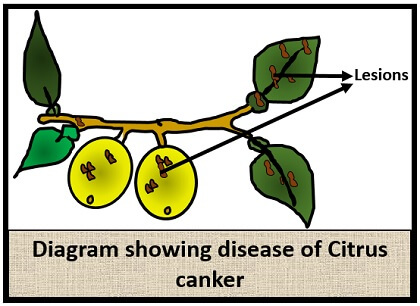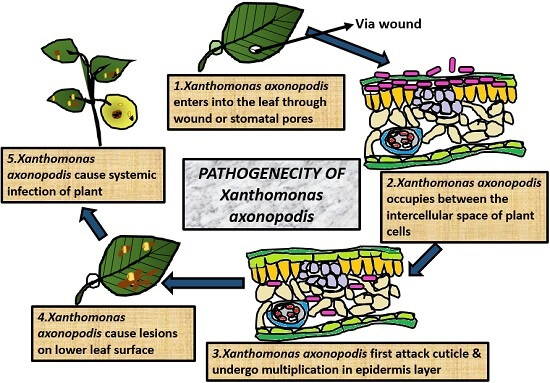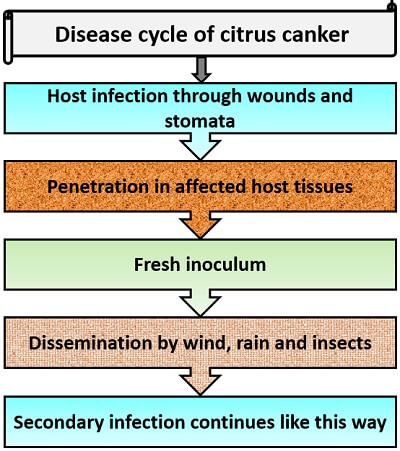Citrus canker disease was originated from Southeast Asia, i.e. India. It is a kind of bacterial disease that can cause endemics in most of the areas because it spreads rapidly by many factors that we will discuss in this content. It has a high potential to cause damage or infect all the surrounding citrus growing fields. Therefore, it can cause huge ecological loss by creating damage to the citrus plant species. Citrus canker disease is favoured by factors like heavy rainfall and warm weather.
Causative agent: Xanthomonas axonopodis
Distribution: Worldwide
Host range: Acid lime, sweet orange and grapefruit plants etc.
Endemics: Brazil and the United States
The disease is characterized by the lesion formation on the leaves and through fruit-rind blemishing. In this context, we will talk over the causative agent and the conditions that favour the occurrence of an infection. Besides, we will study the pathogen life cycle along with its transmission, symptoms and control measures of the Citrus canker disease.
Content: Citrus Canker Disease
- Causative Agent
- Favourable Conditions
- Transmission
- Symptoms
- Pathogenicity
- Disease Cycle
- Control Measures
Causative Agent
Citrus canker is a disease that mainly occurs in citrus plants, which includes lemon, orange, key lime, pomelo, grapefruit plants etc. Its causative agent is Xanthomonas axonopodis that possesses the following features:
- Shape: Rod-shaped
- Gram reaction: Negative
- Motility: It consists of single polar flagella, i.e. Xanthomonas axonopodis has monotrichous flagella.
- Respiration: Xanthomonas axonopodis undergo “Aerobic respiration”.
- Genome: Xanthomonas axonopodis consist of ds-DNA.
- Genome size: The genome size of Xanthomonas axonopodis is 5megabase- pairs.
- Enzymes: Xanthomonas axonopodis contains cellulose, pectate lyase, protease, and type-3 proteins which are responsible for the pathogenicity of the bacteria and acts as “Virulence-factors”. All these enzymes induce host susceptibility in plants, which can destroy or infect the entire crop field.
- Capsule. The mucilaginous capsule is present in Xanthomonas axonopodis.
- Endospore formation: Xanthomonas axonopodis are non-endospore formers.
- Effects: Xanthomonas axonopodis can cause effects like the formation of lesions, yellow-brown watery halos which forms irregularly on the leaves, fruits, stem, branches etc.
- Types: Based on the distribution of Xanthomonas axonopodis, it is of following types:
- Asiatic types of citrus canker: This type of citrus canker is widely distributed in Asia, which is caused by X. axonopodis pv. Citri.
- Cancrosis B: This type of citrus canker is widely distributed in South America is caused by X. axonopodis pv. aurantifolii.
Favourable Conditions for Citrus Canker Disease
Many environmental conditions favour the disease of citrus canker which is as follows:
- Mild temperature between 20-30 ֯ C.
- Wet weather or humidity.
- Strong winds
- Heavy rain
- Citrus leafminer damage
The persistence of rainfall cause rotting in several parts of the plants due to the wet soil. Also, the warm, humid temperature favours the insect population growth, after which the insect vectors may further disseminate the infection in the surrounding citrus growing crops. Besides, factors like strong winds also contribute to the disease cycle of the citrus canker. Citrus leafminer damage is caused by the larvae that feed upon the citrus growing plants. As a result, the larvae expose the tissues of the plants to citrus canker infection by forming tunnels in the leaf foliage.
Transmission of Citrus Canker
The disease of citrus canker disseminates by the following factors which include:
- Plant to plant dissemination: It occurs via the contact of an infected plant with the uninfected one.
- Improper vegetation: The use of wrong vegetative methods and improper handling of the plants also transmits the infection.
- Extrinsic factors: It includes environmental factors like wind, rain etc. that favour the dissemination of infection.
- Insect vectors: Insects transmission is one of the common types of plant disease transmission.
- Water splashing: It also favours disease propagation.
Symptoms of Citrus Canker Disease
The symptoms of citrus canker include:

Initial symptoms: These are characterized by the formation of rough lesions (with a yellow halo around it) on the leaves. The initial symptoms will become visible after 7-10 days of infection.
- The lesions first appear on the lower surface of the leaves as different spots.
- Initially, small and pustular lesions appear on the lower leaves.
- Later, the margin raises out from the lesions with a sunken centre.
- Then eventually yellow halos form around the corky lesions and appear yellowish-brown in colour.
- In the more advanced stage, the lesions form water-soaked margins and appear white to grey in colour. The rupture of these water-soaked margins slowly infects the whole plant body, including upper leaves, stem, branches, fruits, twigs etc.
Later symptoms: These are characterized by the appearance of warty cankers on twigs and stems and the formation of scabby lesions on the fruit-rind. Fruits and stem support the long-term survival of the bacteria and on severe infection, the bacteria cause:
- Defoliation of the leaves.
- The premature death of a plant or shoot dieback.
- Fruit drop
Pathogenicity of Xanthomonas axonopodis
Xanthomonas axonopodis first attacks the cuticle of the plant, after which it enters through the stomatal pores of the leaves either through the rainwater or wound, i.e. by any cut in the leaf. Then in the epidermis, Xanthomonas axonopodis undergoes multiplication and starts increasing its number. After multiplication, it occupies in the intercellular spaces of the plant tissues.
Then, the bacteria damage the middle lamella and enter the mesophyll cells by infecting it. Finally, it causes the formation of lesions starting from the leaf foliage and leading to the other parts like twigs, stem and fruits. Lesion formation results due to the malic acid formation by the intense metabolic activity of Xanthomonas axonopodis.
Disease Cycle of Citrus Canker
The infection starts from the leaf or stem, which disseminates through rain and wind. Thus, these extrinsic factors like wind and water flow carry the inoculum to the uninfected plants. Then the bacterial inoculum slowly causes water congestion inside the stomata and mesophyll cells of the plant tissue. Later, the pre-symptoms appear in the form of lesions on the foliage (Leaves), fruits, stems etc.
The conditions like rain, warm temperature and irrigation methods cause the bacteria to ooze out of the lesions onto the plant surface. Then post symptoms are generally identified by the formation of corky lesions with a yellow-brown halo around it. Likewise, the bacterial inoculum disseminates through various factors, and the disease cycle continues.
Control Measures of Citrus Canker
- Removal or eradication of the infected plants can be done by a burning method, in which the whole infected area is eradicated by burning.
- Pruning can also be done, by which the infected parts of the plants are removed by the pruning scissors.
- Use of disease-resistant varieties of the crop.
- Bordeaux mixture and lime sulphur can be used in the form of sprays to combat the disease.
- Use of neem cake in the field.
- Antibiotic sprays like streptomycin sulphate and phonomycin are also found to be very effective against the citrus canker disease.
Therefore, the disease of citrus canker can be managed through all these control measures.

